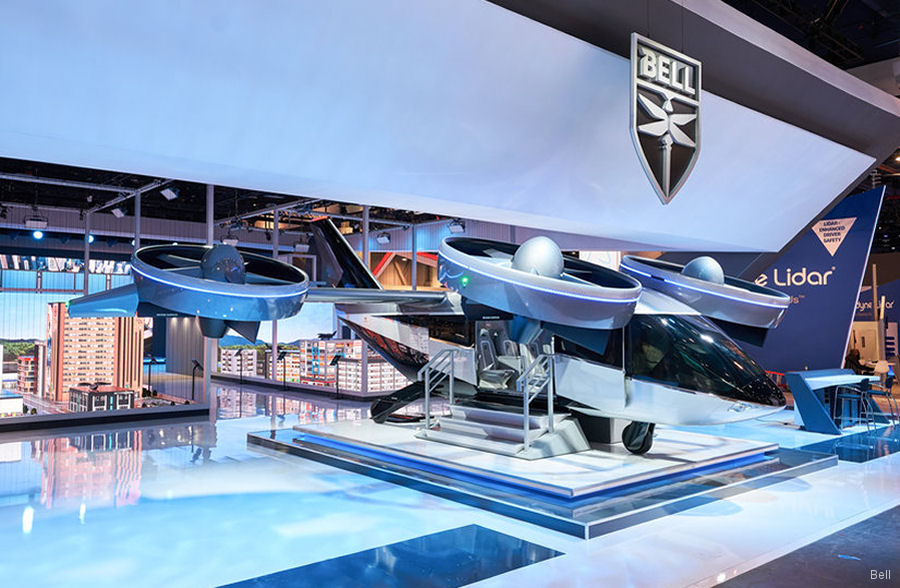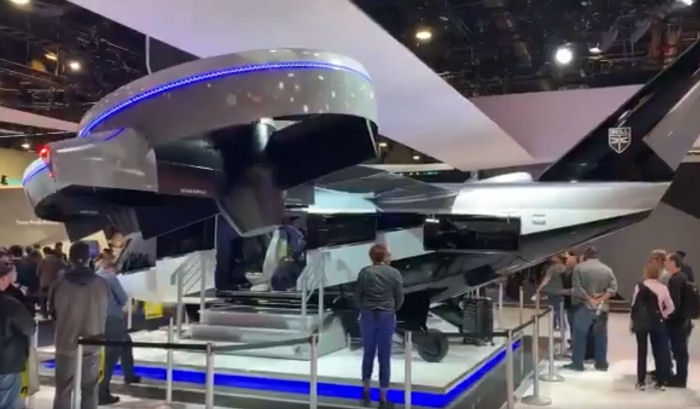
Bell, January 21, 2020 - By Michael Thacker, Employee Value Proposition (EVP9 of Technology and Innovation - Mobility at CES 2020 is maturing from visionary ideas to practical applications.
The public has begun to accept alternative modes of transportation -- from ride sharing and electric scooters to autonomous driving and air taxis -- as either new norms or soon-to-be realities. Concepts and ideas have evolved into full-scale models and production-ready designs.
Now the various industries are taking the next steps in their development. Companies are thinking about how their individual products or technologies interact with the broader ecosystem, how they can be improved in terms of safety or sustainability, and what regulatory and policy questions need to be answered to move toward broad adoption.
“The air mobility experience is soon to be a practical reality”, said Michael Thacker, EVP of Technology and Innovation at Bell. “Now we have to figure out the appropriate regulation and integration into the infrastructure.”
Sustainability
A little over 20 years ago, hybrid automobiles hit the market, bringing eco-conscious transportation to the masses and to the forefront of cultural considerations. Today, that same mindset is expanding to emerging forms of transportation.
The autonomous driving movement, for example, is clearly concerned with sustainability on the CES show floor as most self-driving displays are dominated by eco-friendly considerations. Older vehicle forms like motorcycles are now integrating electric propulsion as well. And urban air mobility (UAM) is no different, with hardware and software platforms driving toward sustainable solutions, including hybrid and all-electric propulsion, as well as fleet management that optimizes vehicle utilization.
Safety
As the public begins to test and adopt emerging transit technologies, both consumers and local governments are clearly concerned with safety. The technologies may have been demonstrated, but they need to work safely and reliably in real-world environments.
In the autonomous driving and mobility as a service (MaaS) spaces, safety is at the top of the priority list and developers are focused on improving technologies like sensors, object and situation identification, machine teaching, navigation, and driver or vehicle monitoring to enhance passenger safety.
And as consumers prepare to enter the skies more casually than ever before with air taxis, developers know they have no margin for error when it comes to safety, consistency of experience and reliability of operations. Technology platforms like Bells’ AerOS flight management system, which tracks vehicle condition with over 300 digital sensors, are key components of ensuring low-risk transportation.
Personal Experiences
One of the most interesting developments to be observed at CES 2020 is the advent of shared transportation with personalized experiences. While sustainability and affordability continue to drive shared service models for both public and private transportation systems, consumer demand still remains for personal and private experiences in those shared spaces.
Creating shared private experiences will be an interesting conundrum for technologists to tackle as we bring these products and services to market. It appears, however, that many of the innovations, like AR, VR, bio-informatics and AI, that are being developed for other applications can provide near term solution options.
Broader Ecosystems
And finally, technologists are now ready to work together. After developing new products in silos for years, these emerging transportation industries are now embracing as partners all the other stakeholders in the system, from city, state and federal agencies to other transportation providers and businesses. For ride sharing services, autonomous vehicles, and aerial vehicles to reach their potential, they must work together seamlessly and fit into the broader smart city infrastructure and ecosystem.
This is why much of the Bell CES booth features a mini smart city, complete with functioning drones taking off from and landing on vertiports positioned on the tops of schools, companies, and airports, operated by an intelligent, integrated fleet management system (AerOS).
And it’s why much of the conversations between technologists and consumers center around policy, regulation and infrastructure. “Frankly, the aircraft is not the hard part,” said Thacker. “We need to ensure the infrastructure and ecosystem are ready for the aircraft to fly and the best way to do that is to engage with communities to help modernize and improve their entire multimodal transportation system.”
The public has begun to accept alternative modes of transportation -- from ride sharing and electric scooters to autonomous driving and air taxis -- as either new norms or soon-to-be realities. Concepts and ideas have evolved into full-scale models and production-ready designs.
Now the various industries are taking the next steps in their development. Companies are thinking about how their individual products or technologies interact with the broader ecosystem, how they can be improved in terms of safety or sustainability, and what regulatory and policy questions need to be answered to move toward broad adoption.
“The air mobility experience is soon to be a practical reality”, said Michael Thacker, EVP of Technology and Innovation at Bell. “Now we have to figure out the appropriate regulation and integration into the infrastructure.”
Sustainability
A little over 20 years ago, hybrid automobiles hit the market, bringing eco-conscious transportation to the masses and to the forefront of cultural considerations. Today, that same mindset is expanding to emerging forms of transportation.
The autonomous driving movement, for example, is clearly concerned with sustainability on the CES show floor as most self-driving displays are dominated by eco-friendly considerations. Older vehicle forms like motorcycles are now integrating electric propulsion as well. And urban air mobility (UAM) is no different, with hardware and software platforms driving toward sustainable solutions, including hybrid and all-electric propulsion, as well as fleet management that optimizes vehicle utilization.
Safety
As the public begins to test and adopt emerging transit technologies, both consumers and local governments are clearly concerned with safety. The technologies may have been demonstrated, but they need to work safely and reliably in real-world environments.
In the autonomous driving and mobility as a service (MaaS) spaces, safety is at the top of the priority list and developers are focused on improving technologies like sensors, object and situation identification, machine teaching, navigation, and driver or vehicle monitoring to enhance passenger safety.
And as consumers prepare to enter the skies more casually than ever before with air taxis, developers know they have no margin for error when it comes to safety, consistency of experience and reliability of operations. Technology platforms like Bells’ AerOS flight management system, which tracks vehicle condition with over 300 digital sensors, are key components of ensuring low-risk transportation.
Personal Experiences
One of the most interesting developments to be observed at CES 2020 is the advent of shared transportation with personalized experiences. While sustainability and affordability continue to drive shared service models for both public and private transportation systems, consumer demand still remains for personal and private experiences in those shared spaces.
Creating shared private experiences will be an interesting conundrum for technologists to tackle as we bring these products and services to market. It appears, however, that many of the innovations, like AR, VR, bio-informatics and AI, that are being developed for other applications can provide near term solution options.
Broader Ecosystems
And finally, technologists are now ready to work together. After developing new products in silos for years, these emerging transportation industries are now embracing as partners all the other stakeholders in the system, from city, state and federal agencies to other transportation providers and businesses. For ride sharing services, autonomous vehicles, and aerial vehicles to reach their potential, they must work together seamlessly and fit into the broader smart city infrastructure and ecosystem.
This is why much of the Bell CES booth features a mini smart city, complete with functioning drones taking off from and landing on vertiports positioned on the tops of schools, companies, and airports, operated by an intelligent, integrated fleet management system (AerOS).
And it’s why much of the conversations between technologists and consumers center around policy, regulation and infrastructure. “Frankly, the aircraft is not the hard part,” said Thacker. “We need to ensure the infrastructure and ecosystem are ready for the aircraft to fly and the best way to do that is to engage with communities to help modernize and improve their entire multimodal transportation system.”


See also |
Bell Nexus 4EX at CES 2020




